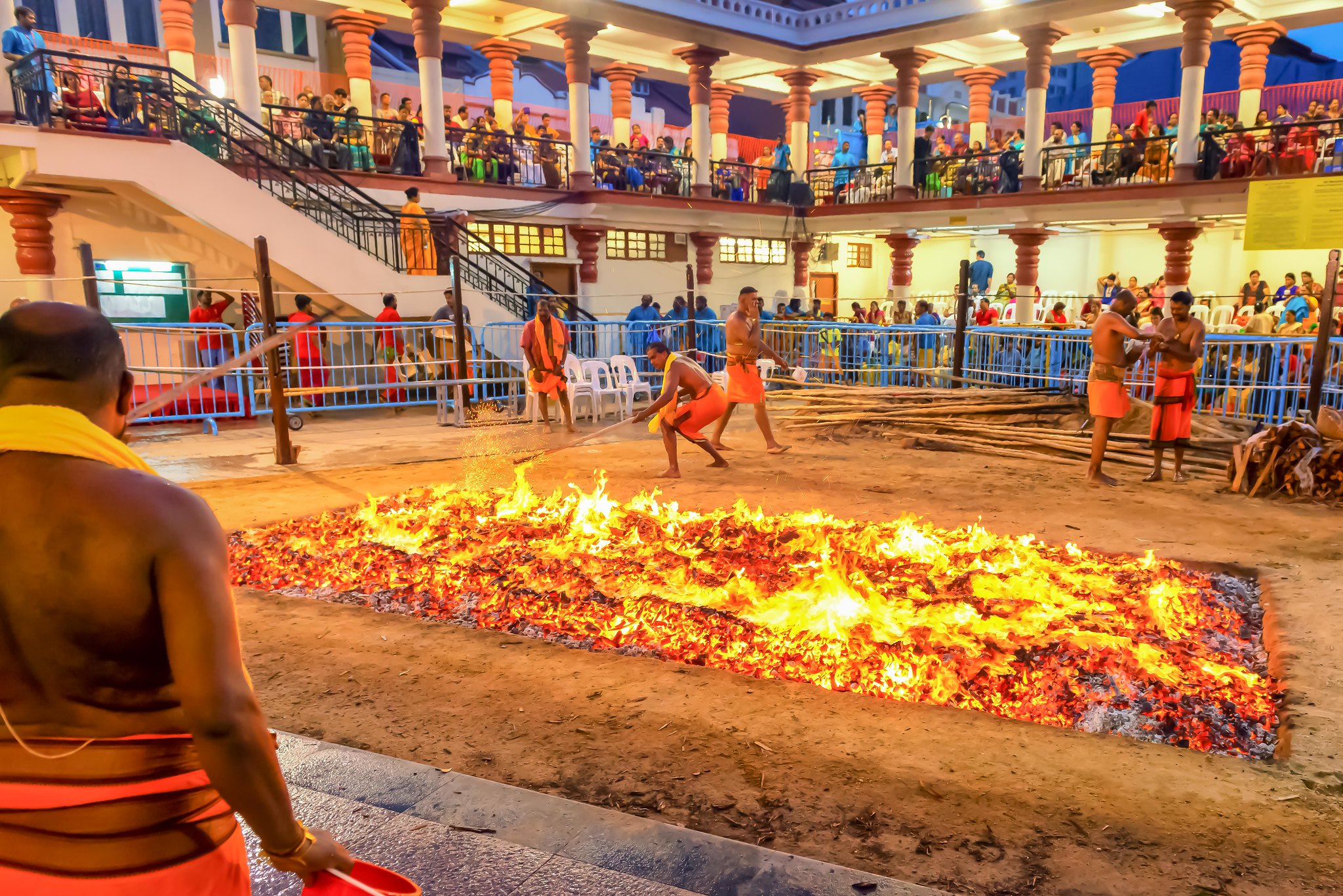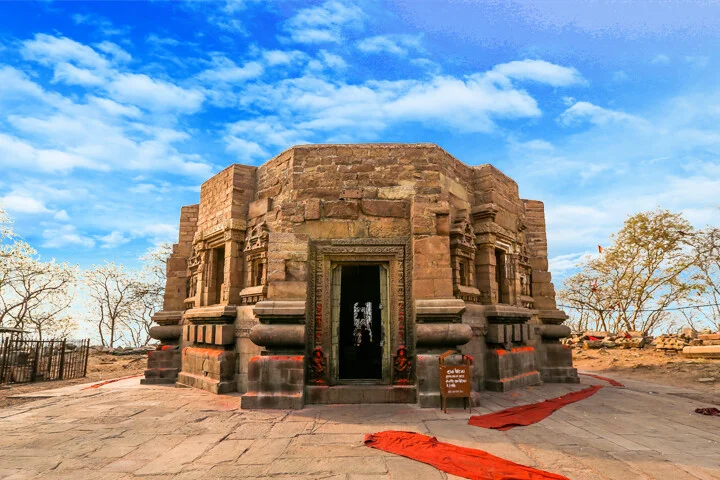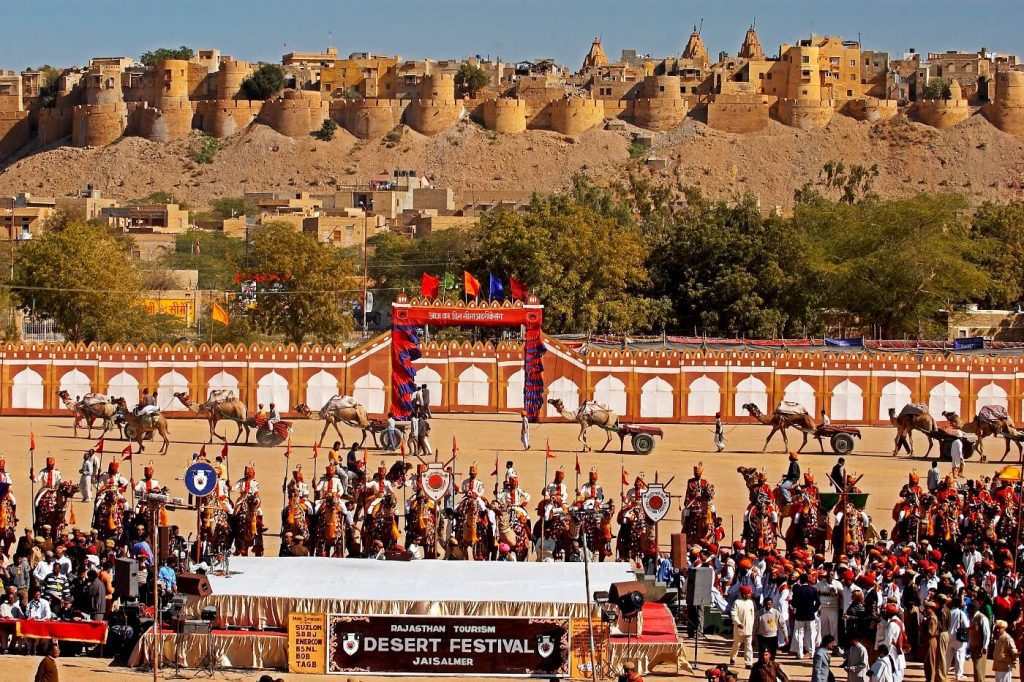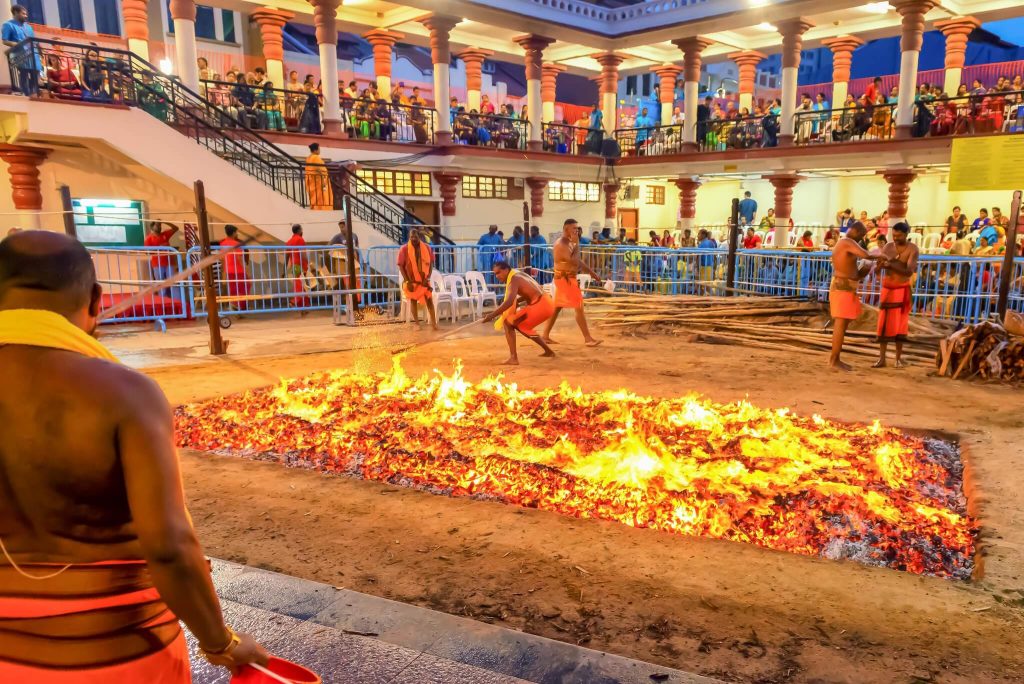
Did you know that there is a fire walking festival in India? If you are interested in learning more about the unique festivals that’s celebrated in India, this article on fire walking festival Thimithi is for you.
Picture yourself in the dark with the moon hanging in the sky, and a whiff of smoke pervades the warm air, stinging your eyes. Looking down, you see the glimmer of burning embers, some of which are as hot as 535 degrees Celsius, strewn on the ground below. A rhythm of beating drums fills your ears as Draupadi from the Mahabharata is honoured. The entire village is engulfed in the moment, as the richness of the surrounding imagery absorbs the senses. As the blazing embers lay before you, you are in a state of euphoria. But, will you walk through fire?
This is a snapshot of Thimithi, the fire-walking festival celebrated in Tamil Nadu.
What is Thimithi?
Fire has long been an essential aspect of Hindu ceremonies in India, from tiny pujas to large weddings, due to its sacred significance. The festival of Thimithi, on the other hand, takes this fervent devotion to fire to a whole new level with its fire-walking rite – a spiritual consecration to Draupati Amman, an incarnation of goddess Mariamman. Goddess Mariamman is believed to have created villages and is considered to be the guardian of the village boundaries in this part of the world.
Theemithi or Thimithi is a South Indian festival held a week before Diwali in the month of Aippasi of the Tamil calendar, where the act of walking barefoot over a bed of hot embers or stones is observed. It generally falls between October and November in the Gregorian calendar. If you’re travelling to Tamil Nadu before Diwali, chances are you can experience this festival, as it is expected to fall on October 28 in 2021.
Thimithi, a part of a two-and-a-half-month ceremony, is a culmination of numerous rituals in which scenes from the battle of Mahabharata between the Pandavas and Kauravas are reenacted.
Also Read: Experience Live: Unforgettable Indian Festivals!
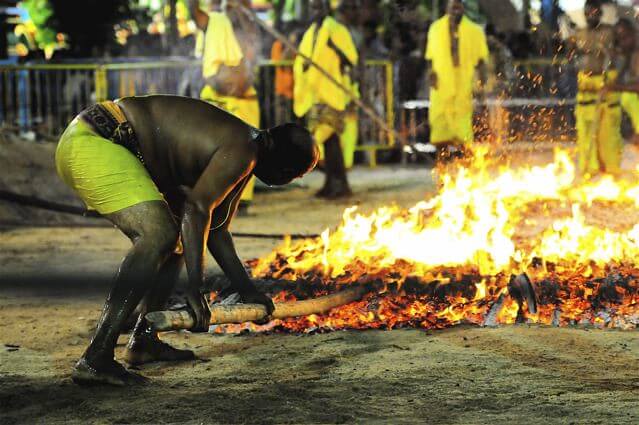
Why is Thimithi celebrated?
Thimithi is a penance performed by people to Draupadi Amman, the heroine of the Mahabharata and wife of the Pandavas. Draupadi walked on fire at the end of her victory over the Kauravas to display her virtuosity and purity and emerged unscathed.
The festival of Thimithi is celebrated to express their devotion to Draupadi. It provides devotees with an opportunity to express, prove, reaffirm, and even test their beliefs. The notion is that if a person walks slowly and steadily on the blazing embers of the fire, he or she would be free of all catastrophes and bad health. Some devotees do this as a form of gratitude for getting rid of their difficulties. Some do it to fulfil long-held aspirations. It is also believed that the fire walking ceremony protects not just the person who does it, but the entire village.
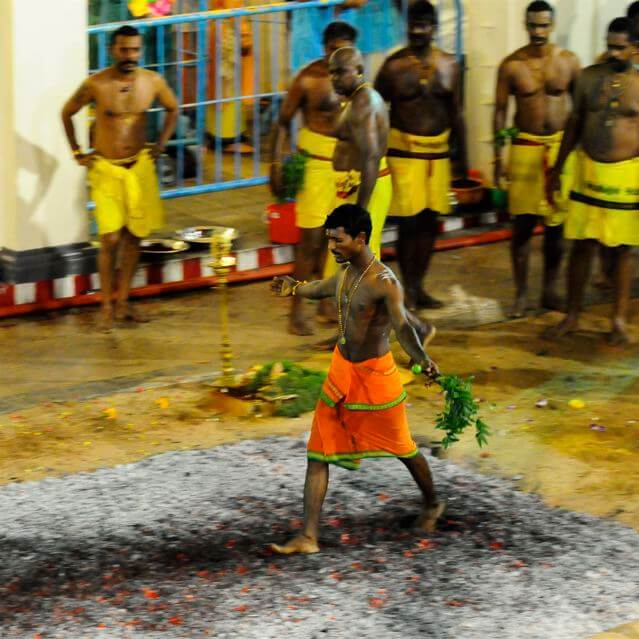
How is Thimithi celebrated?
As the village gears up for the festivities with fervour, it begins with the hoisting of a flag with the image of Arjuna and Hanuman, one week before Diwali. Starting this day, the Mahabharata is read every night until two days following the fire walking festival Thimithi.
There is a sense of divine spirituality that simmers among devotees as Thimithi approaches, as fasting and daily prayers are observed up to three weeks before the ceremony as preparation and purifying steps.
The ritual attracts dozens of people from the area, who chant the names of goddess in loud voices synched with the beating of the drums and the racing anticipation. On Thimithi, a 2.7 meter fire pit is excavated at the temple and milk is poured into a smaller hole at the end.
Before the devotees walk on fire, all the lights in the area go off, and the only thing you will be able to see is the burning coal. The crowd stare in silence as the fire walkers rush onto the embers. This marks the highlight of this ceremony.
As the prayers are chanted, the pit is ignited with sandalwood pieces. Turmeric and neem leaves are tied to the wrists of the fire-walking participants. Following the offering of prayers, wood is lighted and keeps burning until the trench is a trail of still-flaming embers, as some devotees fan the fire with thick matted pads.
The ritual commences with the chief priest walking across the fire pit with a sacred pot called Karakam on his head. The devotees follow him barefoot, with closed eyes, almost intoxicated with devotion and the emotions of the moment. Most of them show no signs of pain or inconvenience. In fact, they seem rather calm and peaceful.
Even as a spectator, you are bound to feel a swell of emotion while watching the fire walkers, and perhaps even the deep mystery and divinity of the moment. After the walk on fire, devotees cool their feet in a pit filled with cow’s milk, and the pit is extinguished with the sacred milk and water from the temple’s firehose.
[Also Read: Devaragattu Dasara – Kill or Get Killed]
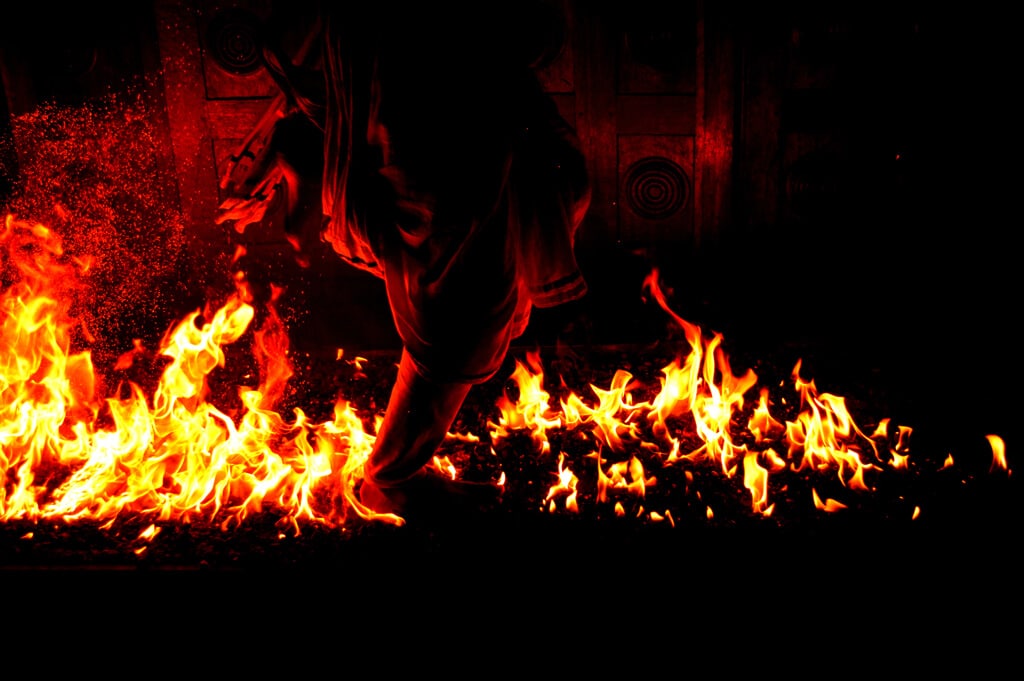
What does science say about Fire-Walking?
According to science, embers are poor heat conductors. Hence, less heat is transmitted to human feet. Since the fire walker is walking, the time of contact between feet and coals is minimal. The duration is too short for the coals to burn or char the feet.
However, some participants in this ceremony suffer from bruises and burns on their feet. It is said that if a devotee is not pure, he or she will fail the test and be burnt. Despite that, you will observe that devotees demonstrate their utmost love and devotion to the goddess by enduring the pain and heat.
The festival ends two days after Thimithi, with the reading of the last chapter of the Mahabharata and the lowering of the flag that was raised on the first day.
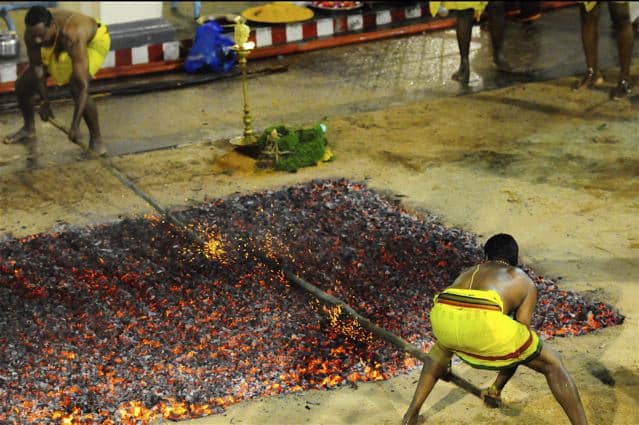
Where is Thimithi celebrated?
It is claimed that the festival has been held for the past two centuries at Kanni Amman Kovil temple in Manappakkam village in Chengalpattu in Tamil Nadu. It is interesting to note that this practice is also observed in countries like Trinidad, the Fiji Islands, Bulgaria, Tahiti, Singapore, and Mauritius.
The strength and determination the devotees exude as they tread over the fire bubbling through the intensity of red-hot rubble and ash, with parts of their soles burned, is a sight to behold.
How to reach Chengalpattu?
The closest metro city to Chengalpattu is Chennai which is about 60 km from the village. Witness the splendor of the festival by booking a car rental in Chennai with a local driver.
Install Savaari cab booking app for offers and discounts on outstation rentals.
Last Updated on January 31, 2024 by Swati Deol
